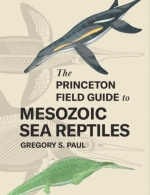Добрый день, Коллеги. Важное сообщение, просьба принять участие. Музей Ферсмана ищет помощь для реставрационных работ в помещении. Подробности по ссылке
The Princeton Field Guide To Mesozoic Sea Reptiles / Принстонский полевой справочник по морским рептилиям мезозоя
The remains of ancient sea reptiles have been found by humans for millennia and may have helped form the basis for belief in mythical beasts, including dragons and sea serpents. In the prescientific West the claim in the Genesis creation story that the planet and all life were formed just two or three thousand years before the great Egyptian pyramids were built hindered the scientific study of fossils.The peculiar, incomplete remains of plesiosaurs become public knowledge, albeit without any understanding of what they were, well back in the 1600s and continuing into the 1700s, when the also incomplete and fishlike fossils of ichthyosaurs, thought to be those of fish, also came to public attention. In the late 1700s mosasaurs began to show up, and in the early 1800s a budding scientific community, increasingly aware that many fossils represented creatures no longer alive on the planet, began to realize that plesiosaurs, ichthyosaurs, and mosasaurs represented exotic extinct groups of aquatic reptiles, often quite large. Mosasaurs in particular were recognized—by the great anatomist Georges Cuvier, who helped establish paleozoology—as true lizards specialized for a marine lifestyle, while the systematic position of the other groups remained obscure
other than that they were some form of reptile, not the fish, amphibians, crocodilians, marine mammals, or preflood humans some had been mistaken for. <...>




